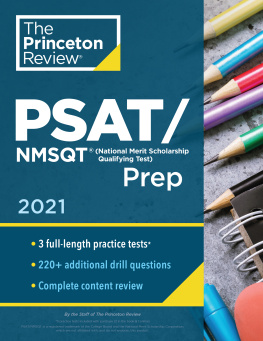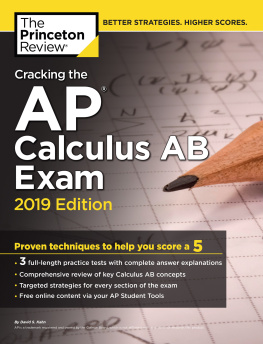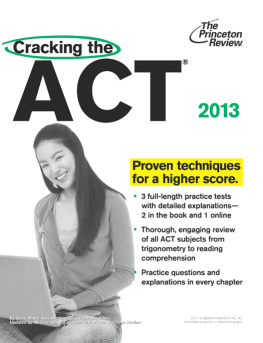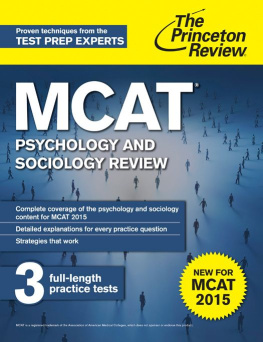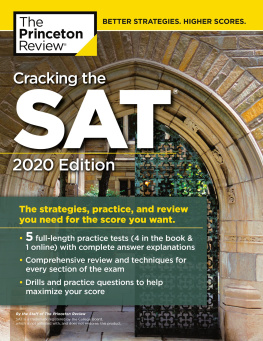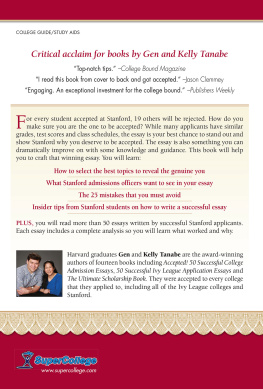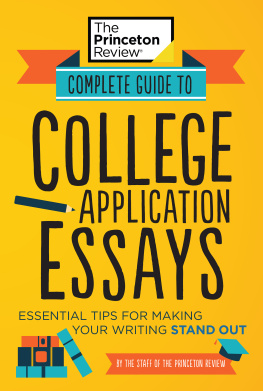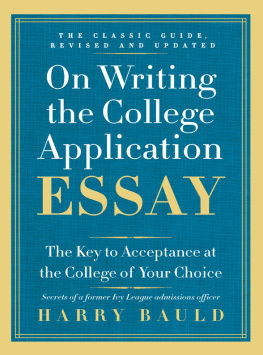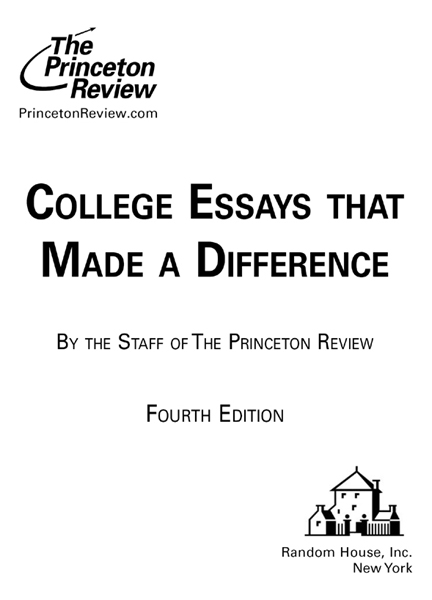The Princeton Review, Inc.
111 Speen St., Suite 550
Framingham, MA 01701
E-mail:
2010 by The Princeton Review, Inc.
All rights reserved under International and Pan-American Copyright Conventions. Published in the United States by Random House, Inc., New York, and simultaneously in Canada by Random House of Canada Limited, Toronto.
eISBN: 978-0-375-42715-2
SVP, Publisher: Robert Franek
Editor: Laura Braswell
Production Editor: Kristen OToole
v3.1
ACKNOWLEDGMENTS
This book would not have been possible without the following individuals here at The Princeton Review, who granted us the opportunity to make the fourth edition of College Essays a reality; Robert Franek, who was instrumental in the development of this title; Scott Harris and Kristen OToole, who transformed the various pieces of the manuscript into the book now in your hands; and Laura Braswell, who provided much valuable input along the way.
Thirteen admissions officers kindly set aside time to speak with us about the particulars of their institutions undergraduate admissions process: Martha Allman, John Corona, Margit A. Dahl, Mark Davies, Stephen Farmer, John Latting, Mitchell Lipton, Carol Lunkenheimer, Duncan Murdoch, Parke Muth, Tom Parker, Lorne T. Robinson, and Michael Zaletel.
The folks most vital to this book, of course, are the contributorsamazing students who took time out of their busy lives to stay in touch and answer questions. To each student who participated in this project: Many thanks for your patience, hard work, and generosity. We commend you for having the guts to lay it all out there for the benefit of future generations of college applicants.
CONTENTS
INTRODUCTION
Why did we produce this book?
For a couple of reasons. First, we wanted to provide a little inspiration to students sweating over their application essays to highly selective colleges. Too many freaked-out high schoolers with outstanding academic and community service records, enviable SAT and ACT scores, and impressive sports achievements have complained that they dont know what to write about or where to start. Hopefully this book will show that there are a million different ways to approach the essay and that if a student reflects on whats most important, he or she will indeed have something to write about. Our evidence is enclosed herewith: actual essays that got living, breathing high school studentskids with crushes and acne and big feetinto the colleges of their dreams.
These students wrote about scores of things, from their love of horses to the shortcomings of being short to the importance of personal hygiene. There are sad tales full of tragedy, homesickness, and civil war, as well as funny stories involving puberty, public embarrassment, and infomercials. There are stories of achievement and of failure, of love and death, of relationships with God, and of spirituality.
Like most collections of prose featuring many diffirent authors, the pieces in this book display a range of creativity and sophistication with the written word. Some essays are so good they may intimidate you; others might make you say to yourself, Hey, I could write something like that. Others are so strange and unexpected you may wonder how on earth some of the most discriminating colleges in the country accepted into their freshman classes the people who wrote them. Which brings us to the second reason we produced this book: to give you a better understanding of the regularities and irregularities of selective college admissions. Along with each essay in the book, you will find the high school GPA; extracurricular activities; hometown; race; and SAT, SAT Subject Test(s), and ACT scores, where applicable, of the student who wrote itall criteria competitive schools may consider in their admit decisions. In addition, we provide the college or university each student enrolled at and their expected or actual year of graduation. Sure, you can find average SAT scores and GPAs of last years freshman class in most college guides, but what youll find here are the profiles of individual applicants who are currently enrolled at, or have graduated from, the most selective undergraduate schools in the nation. To top it off, weve also included interviews with admissions officers at thirteen stellar schools to help shed a little light on what happens on the other side of the admissions fence.
How can this book help you?
We dont comment on individual essays, applicants, or admissions results; we simply present the information to you. After considering the information for the applicants who enrolled at a given college (for most colleges in the book we profile more than one successful applicantsee ), youll start to get an idea of what you needin terms of academic competitiveness, essay quality, extracurricular activities, etc.to gain admission to it. Whats more, we provide a list of the other schools to which each student profiled in the book applied and the ultimate results of those applications. By studying these results, you can start to gauge what your own success rate will be at the various mega-selective colleges in America. Even if you do not plan to apply to the same schools as the students included in this book, the quality of the essays and the strength of the students overall applications can be used to measure your own writing and credentials.
Ideally, these essays will inspire you, supply you with paradigms for narrative and organizational structures, teach you ways to express yourself you hadnt yet considered, and help you write exactly what you wish to communicate.
This book should also help prepare you to encounter both success and failure with your college applications. Youre going to be a bit perplexed when Harvard accepts, Columbia waitlists, and Stanford rejects a student in the book. As youll see, even wunderkindsweve profiled plenty of themget denied admission to top-flight schools. In fact, very few of the students you will encounter in this book got into every college to which they applied. So what should this mean to you? It means that failure is a part of life, even when youve busted your hump working on whatever it was that ultimately failed. But even if you do get a rejection letter, theres no reason to feel completely bereft: a few fat envelopes are probably finding their way to you.
Whyd they do it?
Why would students allow us to publish their essays, test scores, grades, and personal biographical information? They realize the value their stories have for prospective college students. After all, successfully navigating the process of selective college admissions is no small feat. Many said they were honored to have been chosen for publication and to have been given the chance to help the next generation of applicants.
Which students did we accept submissions from, and why?
We only accepted submissions from current students at, or recent graduates of, colleges and universities that received very high selectivity ratings in our flagship book, The Best 373 Colleges. Students and alumni of the following schools appear in the book:
Amherst College
Bard College
Barnard College
Brandeis University
Brown University


